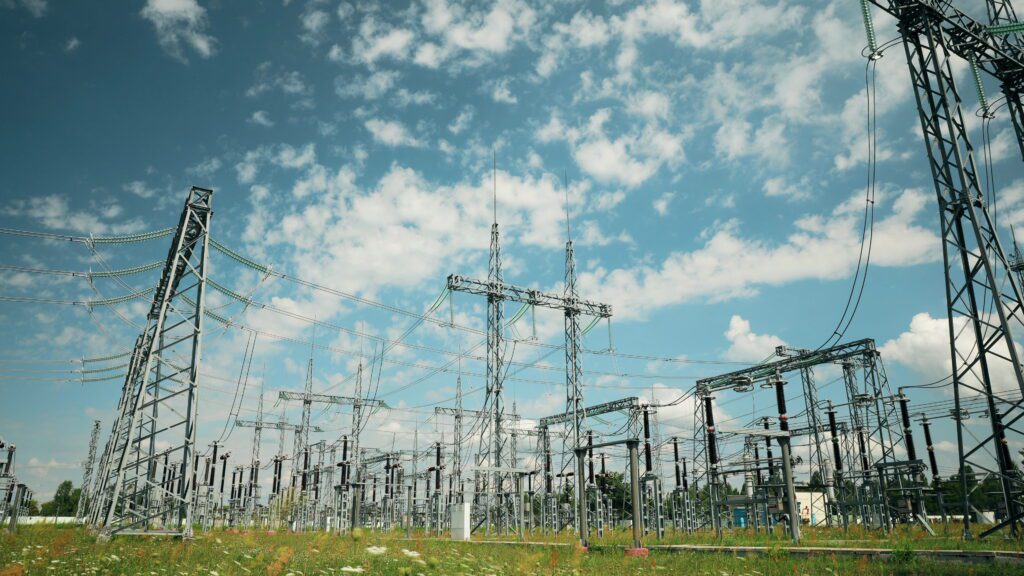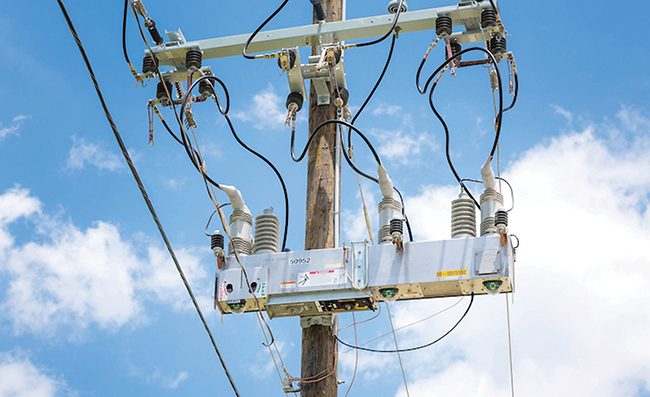Improving the U.S. Electric Power Grid: Mitigating Vulnerabilities and Enhancing Operation
The U.S. power grid has many vulnerabilities, but power companies, with additional support from the government, are investing in the system and enhancing its operation through new innovative technology.
The electric power grid is arguably the single most important infrastructure that exists in the U.S. Almost everything in the country depends on having reliable electricity to function properly. The government, industries, commercial entities, emergency response teams, military operations, and more, would all be seriously handicapped without electricity.
The U.S. Department of Energy (DOE) has reported that more than 70% of the nation’s power transmission lines and transformers are greater than 25 years old (Figure 1). Therein lies one of the biggest vulnerabilities, as equipment doesn’t last forever. Older components are more prone to failure.

Many grid components are exposed to harsh environments. Over time, environmental factors such as temperature changes, humidity, and exposure to weather, as well as other stresses and strains on the system, can cause wear and tear, leading to breakdowns. Insulation can weaken and metal components can corrode, making both more prone to failure. The longer transformers, breakers, and cables have been in service, the more likely they are to have experienced some form of overloading, which can cause overheating and damage. This, too, can lead to failures, especially when components are operated beyond design parameters for extended periods.
The U.S. government recognizes that the grid needs attention. “Extreme weather events like the Dixie Wildfire, Hurricane Ida, and the 2021 Texas Freeze have made it clear that America’s existing energy infrastructure will not endure the continuing impacts of extreme weather events spurred by climate change,” the DOE has said. Aged components require replacement.
Meanwhile, utilities must also expand systems to account for expected growth. The DOE, citing independent estimates, expects U.S. electricity transmission systems to increase by 60% by 2030, and it said the grid may need to triple in size by 2050. Much of the growth will result from widespread electrification, including in the transportation sector.
“With more demand for electricity, and more vital functions depending on a reliable supply, the grid is changing and it needs to be able to generate, and distribute, much more power than it did in the past,” Kumar Chandran, senior director of Commercial Strategy with S&C Electric Co., told POWER. “At the same time, the increased frequency and intensity of storms and other weather events poses a big threat to the grid. The distribution portion of the grid, which has minimal automation, is especially vulnerable to significant impacts during weather events, and afterwards, when it takes considerable time to rebuild damaged infrastructure.”
Investing in the Future
In an article published several years ago by The Bridge, a National Academy of Engineering publication, Theodore U. Marston, principal for Marston Consulting, wrote: “The overarching challenge for the U.S. power system is how to maintain or replace the aging infrastructure, given the diverse set of owners/operators and financing mechanisms. In contrast to the high-tech sector, where the turnover of technologies is measured in months and characterized by high agility and potentially high profit margins, the electricity system is characterized by a capital stock turnover rate measured in decades, low agility, and small, regulated profit margins. The successful nexus of these very different sectors requires close cooperation.”
Much has been accomplished since Marston’s article was published. The Edison Electric Institute (EEI), an association that represents all U.S. investor-owned electric companies, reports that electric companies have invested more than $1 trillion in critical energy infrastructure over the past decade. EEI claims electric companies spent more than $154 billion in 2022 alone to make the grid “stronger, smarter, cleaner, more dynamic, and more secure.” It also says companies invested nearly $30 billion in 2022 in “adaptation, hardening, and resilience (AHR) initiatives” to strengthen the nation’s transmission and distribution infrastructure.
EEI explains that AHR involves more than just the ability to recover from extreme weather events. It also “involves addressing dynamic and potentially impactful risks by anticipating, withstanding, recovering from, and/or adapting to a wide variety of threats, including extreme weather, wildfires, earthquakes, and cyber or physical security attacks.”
In Marston’s analysis, he divided threats into “natural or environmental threats” and “human-related threats.” He suggested many of the natural or environmental threats, including hurricanes/extreme winds, tornadoes, drought, winter storms/ice/snow, extreme heat/heat waves, and wildfires, would increase with climate change. Among the other natural or environmental threats he cited, Marston said earthquakes could increase in some areas due to local activities, such as fracking, but he saw no reason for increases in the threat posed by geomagnetic storms or wildlife and vegetation. Of human-related threats, Marston predicted cyberattacks, electromagnetic sabotage, and equipment failure due to age could all increase in the future, while he saw no basis for changes in the frequency of physical attacks.
The American Society of Civil Engineers (ASCE) published a Report Card for America’s Infrastructure in 2021. In its report, ASCE evaluated 17 categories of infrastructure, including energy, as well as items such as bridges, dams, and roads, using an A–F school-style rating system. ASCE’s comprehensive assessment of energy infrastructure, which includes transmission and distribution as well as pipeline investments, resulted in a grade of C– at the time. Notably, the grade was an improvement compared to ASCE’s previous report, completed in 2017, when energy infrastructure received a grade of D+.
“Utilities are taking proactive steps to strengthen the electric grid through resilience measures. However, weather remains an increasing threat,” the ASCE report says. “[D]istribution infrastructure struggles with reliability, with 92% of all outages occurring along these segments. In the coming years, additional transmission and distribution infrastructure, smart planning, and improved reliability are needed to accommodate the changing energy landscape, as delivery becomes distributed and renewables grow.”
“The grid of today needs to evolve to meet the demands of tomorrow. Fortunately, with proactive investment and careful planning, a more reliable, resilient, and hardened grid that incorporates renewable energy sources is indeed possible,” said S&C Electric’s Chandran.
Chandran predicts the U.S. electric distribution system will change greatly in coming years. “A few years from now, when we look back to 2023, we will realize the use of the distribution part of the grid changed dramatically. It evolved from a one-way power flow delivery system, to an electrical system that keeps as much electricity connected during major weather events, so that afterwards, repairs are quicker and targeted. As all consumers rely so much more on electricity, this reliability and resiliency is critical,” he said.
Chandran said a systemwide approach and investment in innovative technology for power distribution is necessary to reduce vulnerability. Among the solutions he recommended were PulseClosing Technology (Figure 1), lateral automation, and underground fault detection and restoration.

“Customers such as Florida Power and Light (FPL), Oncor, and many others have invested heavily in technologies to harden the grid and as a result have seen significant reductions in storm restoration times,” said Chandran. “These solutions provide great segmentation of the ‘feeder’ from the substation with lateral automation—underground or overhead to the end customer.”
To get the most bang for the buck, companies with limited budgets should start by implementing lateral automation technology. “92% of electric service disruptions happen on the distribution portion of grid, and a majority of those happen on laterals—neighborhood lines—that are protected by a fuse,” Chandran explained. “Newer technology will reduce these disruptions significantly. By replacing fuses with automation, they can reduce the frequency and duration of outage events. One southern utility saw a 74% reduction in sustained interruptions on locations where this technology was deployed.”
Chandran said FPL has been investing heavily in building a stronger, smarter grid for decades, and he believes the benefits have far outweighed the costs. While no power grid is hurricane-proof, detailed assessments have confirmed the resiliency of FPL’s storm-hardened energy grid. “After Hurricane Ian last fall, FPL restored power to two-thirds of its customers after just one full day,” Chandran said. “Just eight days after the high-end storm exited the state, FPL was essentially able to restore power to all of its more than 2.1 million customers impacted by Ian.”
Grid Enhancing Technologies
In April, the WATT Coalition (Working for Advanced Transmission Technologies), a coalition of companies interested in bringing technology solutions to the U.S. electric transmission system to improve reliability and efficiency, published a 30-page paper by The Brattle Group titled Building a Better Grid: How Grid Enhancing Technologies Complement Transmission Buildouts. The research considered three grid-enhancing technologies (GETs): Dynamic Line Ratings (DLR), Flexible Alternating Current Transmission Systems (FACTS), and Transmission Topology Control.
The paper explains that DLR is a representative application that tries to better address the transfer capability of individual lines. Meanwhile, FACTS—a common category of power electronics–based devices that allow for flexible and dynamic control of transmission systems—are examples of hardware solutions focusing on controlling the flow, and is functionally similar to phase-shifting transformers, also known as phase-angle regulators. Lastly, Transmission Topology Control is “an elegant software alternative to these flow control hardware—it controls the flow by adjusting the system topology (for example, by opening or closing circuit breakers) and hence changing the flow distribution that is defined by Kirchhoff’s Law to achieve operational objectives.”
The paper notes, “These technologies represent a new model for increasing grid infrastructure by unlocking additional capacity on the existing transmission system, and can be developed much faster and in a modular least-regrets manner at a small fraction of the cost of traditional transmission projects. Furthermore, they complement transmission buildouts by enhancing the utility of transmission infrastructure instead of eliminating or replacing it.”
The research quantified how GETs reduce costs and improve transmission system planning and operations at all stages of transmission development. The WATT Coalition said GETs can reduce congestion by 40% or more before construction projects even begin. During construction, outages can be “avoided or ameliorated, with similar reductions in congestion costs of 40% or more,” it said. Then, after construction, utilization on new lines can increase by 16%, improving the benefit-to-cost ratio of the new lines.
“Insufficient transmission capacity is the primary obstacle to the energy transition,” Julia Selker, executive director of the WATT Coalition, said in a statement issued to POWER. “Grid Enhancing Technologies and new transmission lines must be deployed together to achieve the necessary system expansion at the highest speed and lowest cost. The faster and more strategically the U.S. is able to increase transmission capacity, the lower the cost to the planet and the ratepayers.”
—Aaron Larson is POWER’s executive editor.